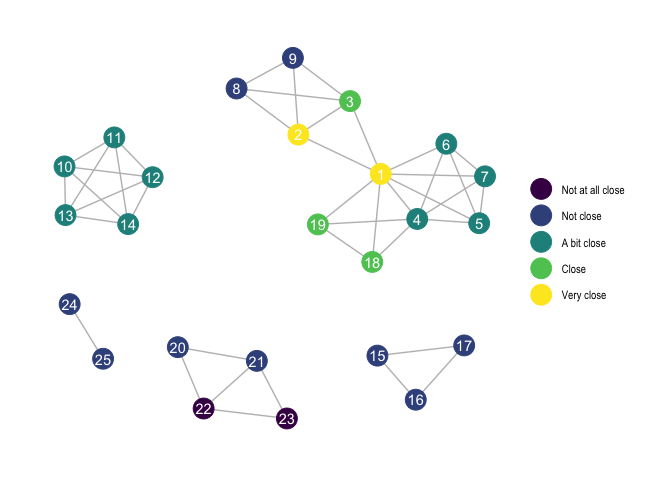Process Data from the Social Networks and Fertility Survey.
FertNet
The goal of FertNet is very specific, namely to process and correct the Social Networks and Fertility Data, with a special focus on the network data. The data was collected through the LISS (Longitudinal Internet studies for the Social Sciences) panel, and can be downloaded from https://www.dataarchive.lissdata.nl/study_units/view/1377. The data is freely available, but requires registration.
The aim of the Social Networks and Fertility Data was to collect personal network data from a representative sample of Dutch women. 758 women each named 25 individuals from their network (so-called alters), reported on several characteristics about these individuals (alter attributes), and also listed the relationships between those 25 individuals (alter-alter-ties). This package helps to deal with this network data by producing dataframes with alter attributes and dataframes with edgelists (alter-alter-ties) and storing them in list-columns. This facilitates later analyses and visualisation of these networks, particularly when these datasets are transformed into tidygraph-objects. Additionally, this package corrects some of the reporting errors of the respondents, and provides sensible variables names and English labels.
For this package it is important that you download the SPSS-version of the data, named wj18a_EN_1.0p.sav from HERE.
Installation
You can install FertNet like so:
install.packages("FertNet")
You can install the development version of FertNet like so:
if (!require("remotes")) install.packages("remotes")
remotes::install_github("gertstulp/FertNet")
Example
The main function of the FertNet package is produce_data. [be sure to have wj18a_EN_1.0p.sav downloaded and in your working directory]
library(FertNet)
#> When you use this package in your work, please cite:
#> Stulp, G. (2023). Describing the Dutch Social Networks and Fertility Study and how to process it. Demographic Research 49(19), 493-512. https://www.demographic-research.org/articles/volume/49/19
data <- produce_data()
produce_data() is a wrapper around several functions, each of which gives some insights into what happens. The below code results in the exact same as produce_data():
data <- read_data() |>
translate() |>
change_column_types() |>
fix_errors() |>
create_relation_labels() |>
create_nw()
Getting more out of the data
The package also allows you to:
Create a new variable to the dataset that is a list-column with
tidygraph-objects. For this, thetidygraphpackage needs to be installed.Add background variables of the respondents. For this to work, you need to download the SPSS-version of the background data from February 2018, named
avars_201802_EN_1.0p.savfrom HERE. The data is freely available, but requires registration.
The below code is therefore probably what most researchers are after.
data <- produce_data(tidygraph_col = TRUE,
background_vars = TRUE)
Let’s produce a visualisation of a network for one of the respondents. This requires the package ggraph.
if (!require("ggraph")) install.packages("ggraph")
library(ggraph)
ggraph(data$tidygraph[[13]], layout = "kk") +
geom_edge_link(colour = "grey") +
geom_node_point(aes(colour = closeness_a), size = 7) +
geom_node_text(aes(label = names_a), colour = "white") +
labs(colour = NULL) +
theme_graph()

The produce_data function comes with one additional argument that allows you to keep the variables on the time it took respondents to answer each question. This information is probably less relevant to most researchers, which is why it defaults to being excluded.
data <- produce_data(remove_timing_vars = TRUE)
Some further details on what the package does
FertNet corrects data entry errors or errors that respondents themselves mentioned in the comments. For more information, please see the file fix_errors.R and Stulp (2020) [reference below]. This package also categorises the outcomes on the 25 variables that describe the respondent’s relation to the 25 individuals in the network (e.g., partner, parent, sibling, known from high school). This also includes processing the ‘qualitative’ data recorded via open text boxes (which occurred 1,159 times). See Buijs and Stulp (2022) [reference below] for further details.
Codebook
The codebook of the dataset resulting from using this package can be found here:
Stulp, G. (2023). Materials for Describing the Dutch Social Networks and Fertility Study and How to Process it. https://doi.org/10.34894/4GG6SH, DataverseNL, V1
Citation
When using this package, please cite:
Stulp, G. (2023). Describing the Dutch Social Networks and Fertility Study and how to process it. Demographic Research 49(19), 493-512. doi.org/10.4054/DemRes.2023.49.19.
Other useful resources on the study
Stulp, G. (2020). Methods and Materials of the Social networks and fertility survey (Sociale relaties en kinderkeuzes), https://doi.org/10.34894/EZCDOA, DataverseNL, V3
Stulp, G. (2021). Collecting large personal networks in a representative sample of Dutch women. Social Networks ,64, 63–71. https://doi.org/10.1016/j.socnet.2020.07.012.
Buijs, VL, & Stulp, G. (2022). Friends, family, and family friends: Predicting friendships of Dutch women. Social Networks, 70, 25–35. https://doi.org/10.1016/j.socnet.2021.10.008.
Stadel, M & Stulp, G. (2022). Balancing bias and burden in personal network studies. Social Networks, 70, 16–24. https://doi.org/10.1016/j.socnet.2021.10.007.
Stulp, G & Barrett, L. (2021). Do data from large personal networks support cultural evolutionary ideas about kin and fertility? Social Sciences 10, 177. https://doi.org/10.3390/socsci10050177.
Stulp, G., Top, L., Xu, X., & Sivak, E. (2023). A data-driven approach shows that individuals’ characteristics are more important than their networks in predicting fertility preferences. Royal Society Open Science 10(12), 230988. doi.org/10.1098/rsos.230988.